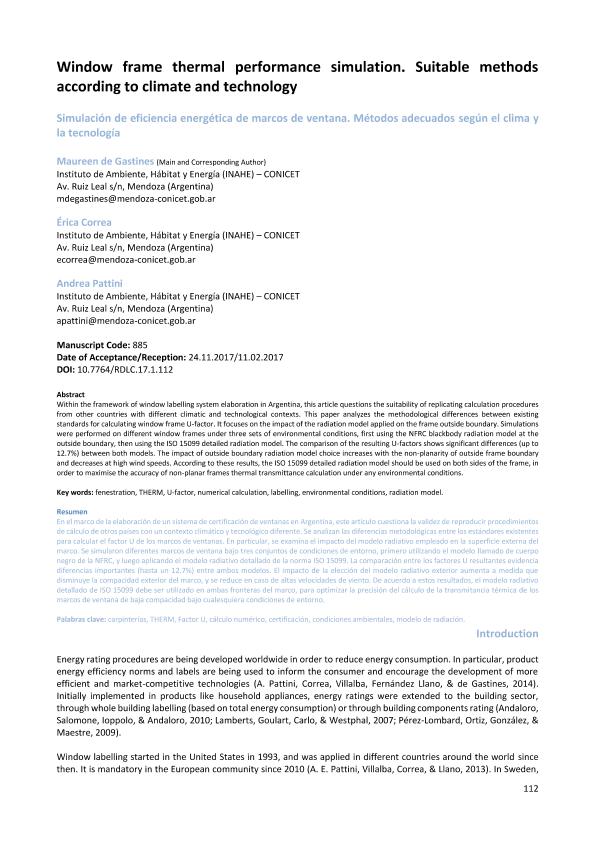Mostrar el registro sencillo del ítem
dc.contributor.author
Macé de Gastines, Maureen Florence Laure

dc.contributor.author
Correa Cantaloube, Erica Norma

dc.contributor.author
Pattini, Andrea Elvira

dc.date.available
2019-11-26T17:38:35Z
dc.date.issued
2018-04
dc.identifier.citation
Macé de Gastines, Maureen Florence Laure; Correa Cantaloube, Erica Norma; Pattini, Andrea Elvira; Window frame thermal performance simulation : suitable methods according to climate and technology; Pontificia Universidad Católica Chile; Revista de la Construcción; 17; 1; 4-2018; 112-122
dc.identifier.issn
0718-915X
dc.identifier.uri
http://hdl.handle.net/11336/90515
dc.description.abstract
En el marco de la elaboración de un sistema de certificación de ventanas en Argentina, este artículo cuestiona la validez de reproducir procedimientos
de cálculo de otros países con un contexto climático y tecnológico diferente. Se analizan las diferencias metodológicas entre los estándares existentes
para calcular el factor U de los marcos de ventanas. En particular, se examina el impacto del modelo radiativo empleado en la superficie externa del
marco. Se simularon diferentes marcos de ventana bajo tres conjuntos de condiciones de entorno, primero utilizando el modelo llamado de cuerpo
negro de la NFRC, y luego aplicando el modelo radiativo detallado de la norma ISO 15099. La comparación entre los factores U resultantes evidencia
diferencias importantes (hasta un 12.7%) entre ambos modelos. El impacto de la elección del modelo radiativo exterior aumenta a medida que
disminuye la compacidad exterior del marco, y se reduce en caso de altas velocidades de viento. De acuerdo a estos resultados, el modelo radiativo
detallado de ISO 15099 debe ser utilizado en ambas fronteras del marco, para optimizar la precisión del cálculo de la transmitancia térmica de los
marcos de ventana de baja compacidad bajo cualesquiera condiciones de entorno.
dc.description.abstract
Within the framework of window labelling system elaboration in Argentina, this article questions the suitability of replicating calculation proceduresfrom other countries with different climatic and technological contexts. This paper analyzes the methodological differences between existingstandards for calculating window frame U-factor. It focuses on the impact of the radiation model applied on the frame outside boundary. Simulationswere performed on different window frames under three sets of environmental conditions, first using the NFRC blackbody radiation model at theoutside boundary, then using the ISO 15099 detailed radiation model. The comparison of the resulting U-factors shows significant differences (up to12.7%) between both models. The impact of outside boundary radiation model choice increases with the non-planarity of outside frame boundaryand decreases at high wind speeds. According to these results, the ISO 15099 detailed radiation model should be used on both sides of the frame, inorder to maximise the accuracy of non-planar frames thermal transmittance calculation under any environmental conditions.
dc.format
application/pdf
dc.language.iso
eng
dc.publisher
Pontificia Universidad Católica Chile

dc.rights
info:eu-repo/semantics/openAccess
dc.rights.uri
https://creativecommons.org/licenses/by-nc-sa/2.5/ar/
dc.subject
ENVIRONMENTAL CONDITIONS
dc.subject
FENESTRATION
dc.subject
LABELLING
dc.subject
NUMERICAL CALCULATION
dc.subject
RADIATION MODEL
dc.subject
THERM
dc.subject
U-FACTOR
dc.subject.classification
Otras Ingeniería del Medio Ambiente

dc.subject.classification
Ingeniería del Medio Ambiente

dc.subject.classification
INGENIERÍAS Y TECNOLOGÍAS

dc.title
Window frame thermal performance simulation : suitable methods according to climate and technology
dc.title
Simulación de eficiencia energética de marcos de ventana. Métodos adecuados según el clima y la tecnología
dc.type
info:eu-repo/semantics/article
dc.type
info:ar-repo/semantics/artículo
dc.type
info:eu-repo/semantics/publishedVersion
dc.date.updated
2019-10-18T18:31:42Z
dc.journal.volume
17
dc.journal.number
1
dc.journal.pagination
112-122
dc.journal.pais
Chile

dc.journal.ciudad
Santiago de Chile
dc.description.fil
Fil: Macé de Gastines, Maureen Florence Laure. Consejo Nacional de Investigaciones Científicas y Técnicas. Centro Científico Tecnológico Conicet - Mendoza. Instituto de Ambiente, Hábitat y Energía; Argentina
dc.description.fil
Fil: Correa Cantaloube, Erica Norma. Consejo Nacional de Investigaciones Científicas y Técnicas. Centro Científico Tecnológico Conicet - Mendoza. Instituto de Ambiente, Hábitat y Energía; Argentina
dc.description.fil
Fil: Pattini, Andrea Elvira. Consejo Nacional de Investigaciones Científicas y Técnicas. Centro Científico Tecnológico Conicet - Mendoza. Instituto de Ambiente, Hábitat y Energía; Argentina
dc.journal.title
Revista de la Construcción

dc.relation.alternativeid
info:eu-repo/semantics/altIdentifier/url/http://revistadelaconstruccion.uc.cl/index.php/rdlc/article/view/1121
dc.relation.alternativeid
info:eu-repo/semantics/altIdentifier/doi/http://dx.doi.org/10.7764/RDLC.17.1.112
Archivos asociados
